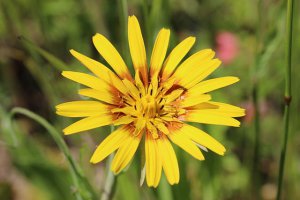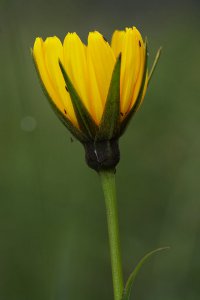A message from EatThePlanet.org: "We are happy you found us! We strive to be informative and accurate. Enjoy what you find here! Take a look at our new downloadable pdf eBook A Complete Guide To Foraging. We put a lot of work into this eBook and are very excited to share it with you." - Joe Forager(Owner)

Meadow salsify (Tragopogon pratensis) is a yellow ornamental biennial wildflower found in the Pacific Northwest and across much of the United States. You can normally find meadow salsify on roadsides, fields, and disturbed sites, usually in areas that are slightly moist.
Meadow salsify is native to Europe, Central Asia, and Turkey. Not much is known about the specific time frame meadow salsify was introduced to the Pacific Northwest, other salsify plants were introduced to the US in the 1900s. Their migration habits and origins are similar so it’s not far off to assume meadow salsify was introduced at the same time.
Meadow salsify goes by other names that are similar to other salsify flowers including jack-go-to-bed-at-noon, meadow goat’s beard, meadow salsify, noonday flower, noonflower, noontide, star of Jerusalem, and yellow goat’s beard. The name meadow goat’s beard references the fuzzy seed head that is produced after flowering and the species’ Greek name pratensis means ‘of the meadows’ and refers to its typical habitat.
Meadow Salsify Edibility and Culinary Use
Meadow salsify is edible and has a number of uses. The roots, leaves, flowering shoots, and flowers are all edible. There are two varieties of meadow salsify that can be used as an edible: purple-skinned root (market variety) and white-skinned root (garden variety).

Meadow salsify is edible and the roots are usually used as a food source. They have a white flesh beneath their skin, which is thin and can be peeled off after soaking in warm water. If they are not soaked the skin is relatively tough. The roots have a texture similar to an artichoke.
The leaves are also edible and can be used as a green in salads, much like lettuce or spinach. They have a mild flavor. If you’re harvesting meadow salsify leaves in the wild it’s best to do so during the spring before they start flowering.
The flowers and flowering shoots also have a similar taste to the leaves and can be used as a green or in salads. The whole flower is edible and there is no need to remove the bitter green part.

Meadow salsify roots and leaves can both be used raw and cooked. They are usually boiled or roasted, which makes them more flavorful. The leaves and roots can also be used in soups or stews to add flavor.
Meadow salsify roots are typically harvested in the fall of their first year, although they can be harvested until the fall of their second year. You can tell if meadow salsify roots are still good by testing the skin with your teeth; it should be somewhat tough and give a bit.
Meadow Salsify Health Benefits
Thanks to its high nutrient content, meadow salsify has many health benefits including regulating blood pressure, improving digestion, improving circulation, boosting the immune system, and promoting bone health.
Meadow salsify is high in fiber and low in calories, similar to other vegetables. It also has a decent amount of protein and amino acids known as methionine, which are helpful in the regrowth and repair of blood vessels..
Meadow salsify contains several minerals including iron, magnesium, potassium, calcium, manganese, zinc, selenium, and phosphorus.
Meadow salsify also has a number of vitamins that are beneficial for health including vitamin K, A, and B9. Vitamin K is not usually abundant in plants and is important for blood clotting, bone formation, and other bodily functions. It may also help with acne. Vitamin A is important for immune system function and eyesight. Vitamin B9 helps your body make healthy blood cells, produce DNA, and metabolize proteins, fats, and carbohydrates. In addition to these vitamins, meadow salsify also has vitamin C, which has antioxidant properties.
Meadow Salsify Cautions
Although meadow salsify is edible, there are some precautions to take when harvesting the root since it can contain saponins, which gives the roots their bitter taste. If you are harvesting meadow salsify roots there are some precautions that should be taken:
- Never eat meadow salsify roots, flowers or flowering shoots raw
- Soak the root in water for fifteen minutes if not peeled prior to cooking.
- Soaking is not recommended for roasted meadow salsify roots
- Never eat the skin of the root if it is extremely tough
- Be sure to boil the root before eating it for at least ten minutes to remove the saponins.
Never eat meadow salsify roots, flowers, or flowering shoots if you are pregnant or nursing.
Saponins are not directly harmful to most people, however, they can raise the toxicity of your body causing you to be more susceptible to other ailments or diseases. It’s best to remove saponins before eating meadow salsify to avoid this toxicity.

Conclusion
Meadow salsify’s growth in the Pacific Northwest has made it a nutritious addition to your foraged meal. Its yellow petals are easy to spot in the morning when the blooms open and more difficult as they close during the early afternoon. Make sure that you remove the saponins when eating any part of the plant to avoid increasing toxicity levels in your body.
————— See our privacy policy for more information about ads on this site
Written by Jared DeValk
Jared DeValk is an author, writer, and entrepreneur who in his free time can be caught hiking, planting berry bushes, or doing home repairs and improvements. Jared's varied life experience and passion for research empassions him to write knowledgeably about many topics such as , Health & Wellness, Real Estate, Finance, Business, Cryptocurrency, Home Improvement, Agriculture, Camping/Hiking, and many more. Jared can be reached directly for speaking, marketing, and writing inquiries at JaredDeValk.com.
Many of our readers find that subscribing to Eat The Planet is the best way to make sure they don't miss any of our valuable information about wild edibles.







One Response
Great article, so wel-written! Thanks!